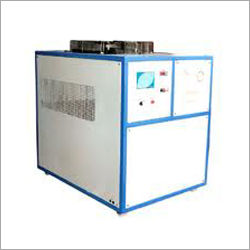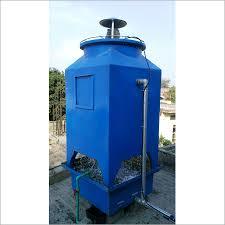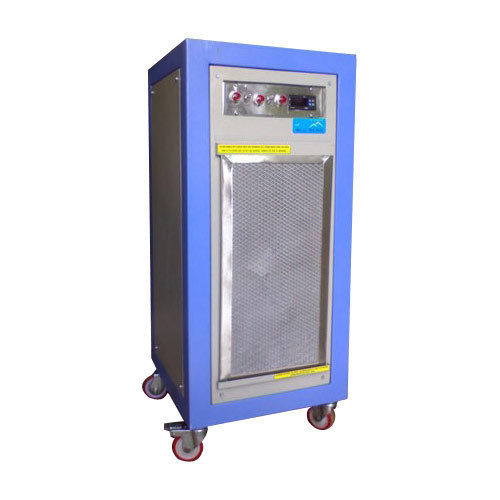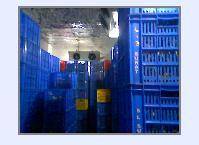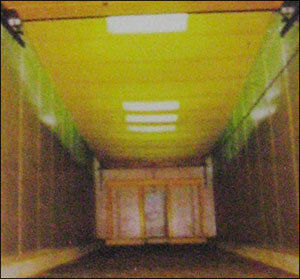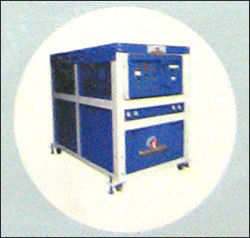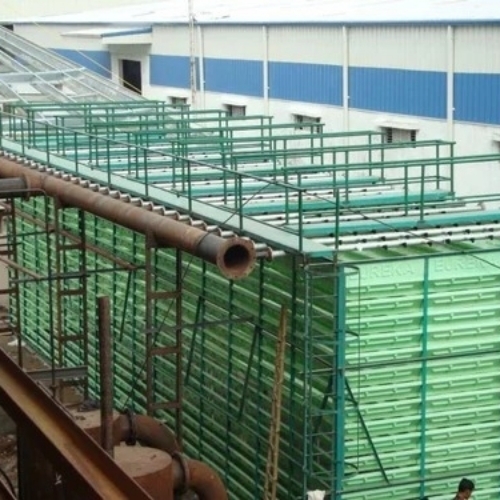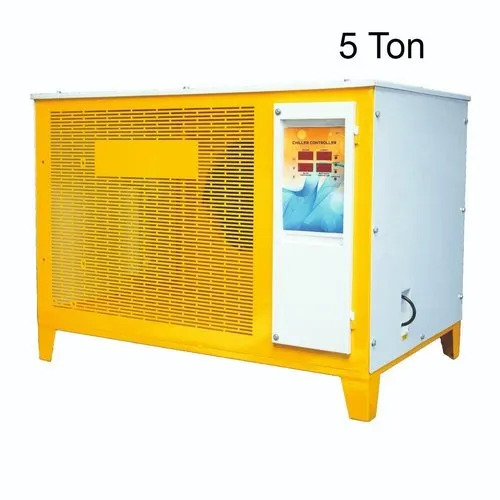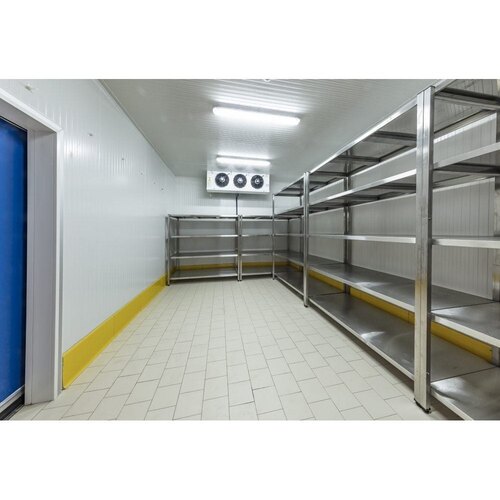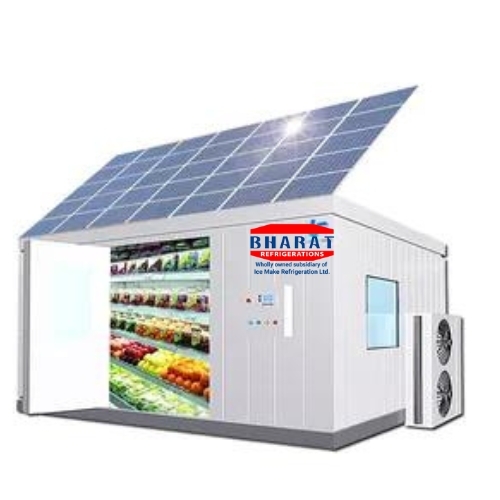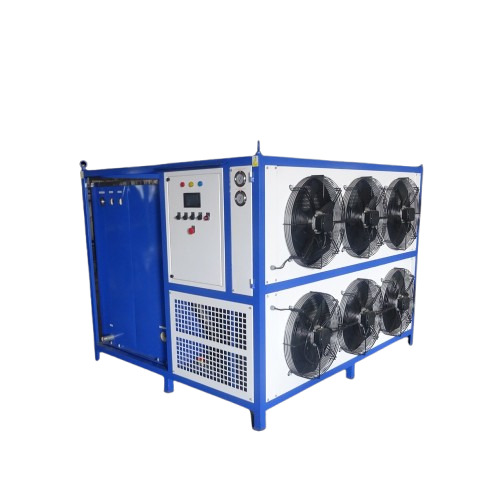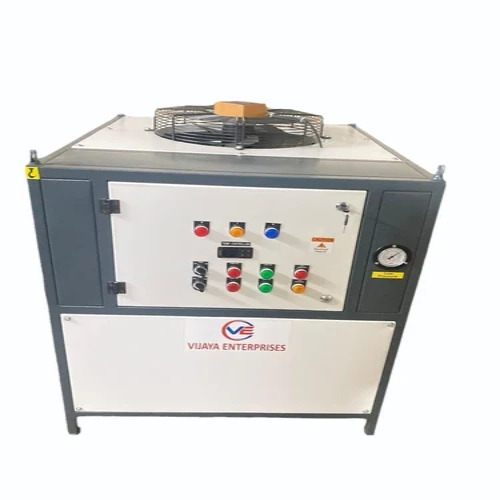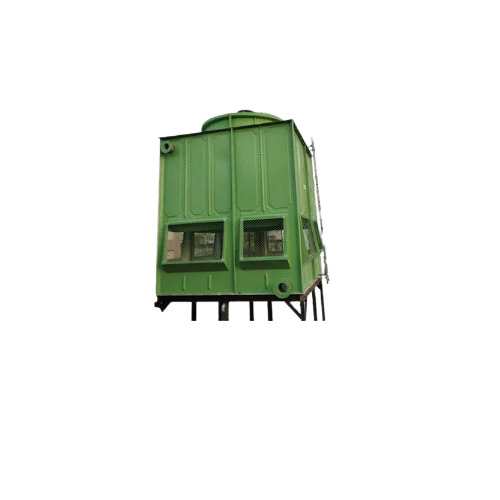Cooling Tower & Chilling Plants
(4045 products)Industrial Cooling Tower - Cooling Coil Material: Stainless Steel
52000.0 INR (Approx.)/Piece
MOQ1 Piece/Pieces
Refrigerating Capacity50 Tons
Air Flow10000 CFM ft3/min (CFM)
Motor3 HP
MaterialOther
ApplicationIndustrial cooling process
ConditionNew
Cooling Towers Solutions - Material: Frp
Price: 100000 INR/Unit
MOQ1 Unit/Units
Product TypeCooling Towers
UsageFor Industrial Use
MaterialFRP
ConditionNew
TypeCooling Towers
Power SupplyElectrical
Aeron Composite Limited
Ahmedabad
 Super Bonanza
Super Bonanza Trusted Seller
Trusted Seller Super Seller
Super Seller14 Years
Water Chilling Plant - Application: Industrial
Price: 100000.00 INR/Piece
MOQ1 Piece/Pieces
SizeStandard
MaterialOther , Mild Steel
ApplicationIndustrial
Product TypeChilling Plant
ColorSilver
ConditionNew
Unique Air Products
Vadodara
 Trusted Seller
Trusted Seller Super Premium
Super Premium15 Years
 Super Premium
Super PremiumShell and Tube Water Cooled Chiller - Copper Cooling Coil, Customizable Dimensions | 75 Ton Refrigerating Capacity, Reliable for Food and Chemical Industries, 12-Month Warranty, 3 Phase Power Supply
Price: 2500000 INR/Number
MOQ1 Number
WidthCustomisable Inch (in)
Product TypeShell and Tube Water cooled
ColorBlue
Water Flowing RateAs per Temperature requirement
MaterialMetal
LengthCustomisable Inch (in)
Everestt Chillers Private Limited
Coimbatore
 Super Bonanza
Super Bonanza Trusted Seller
Trusted Seller Premium Seller
Premium Seller2 Years
FRP Cladding Cooling Tower - FRP Material, Standard Size, Custom Color | Industrial Use, Manual Power Supply, Easy Maintenance
Price: 350 INR/Square Meter
MOQ200 Square Meter/Square Meters
MaterialFRP
UsageIndustrial
SizeStandard
ConditionNew
Power SupplyManual
Everest Composites Pvt. Ltd.
Vadodara
 Trusted Seller
Trusted Seller Super Seller
Super Seller18 Years
High Pressure Fogging System - Stainless Steel, 2-5 HP Motor Power, 100-150 BAR Pump Pressure | Manual Operation, Effective Dust Control and Humidification
Price: 195000 INR/Unit
MOQ1 Unit/Units
UsageCommercial
MaterialMetal
ConditionNew
TypeFogging System
Power SupplyElectric
Voltage220-240 Volt (v)
Amtm Mistjet Private Limited
Jamshedpur
 Super Bonanza
Super Bonanza Trusted Seller
Trusted Seller Super Seller
Super Seller5 Years
Ms Water Cooled Chiller - Color: Black
Price: 57000 INR/Piece
MOQ1 Piece/Pieces
UsageIndustrial
MaterialMetal
ColorBlack
ConditionNew
Warranty1 year
Shree Mangaldeep Sales
Ahmedabad
 Trusted Seller
Trusted Seller Super Seller
Super Seller5 Years
Cellular Drift Eliminators - Application: Cooling Towers
Price: 1 INR/Cubic Meter
MOQ100 Cubic Meter/Cubic Meters
MaterialPVC
ApplicationCooling Towers
ColorBlack
Product TypeCooling Towers
SizeDepth - 5.25, Width - 12, Length - 48inch
ConditionNew
Cooldeck Industries Pvt. Ltd.
Mumbai
 Trusted Seller
Trusted Seller Super Premium
Super Premium Super Seller
Super Seller7 Years
 Super Premium
Super PremiumCooling Tower - Color: Blue
MOQ1 Piece/Pieces
ColorBlue
Product TypeCooling Tower
UsageIndustrial
ConditionNew
TypeCooling Tower
Power SourceElectricity
B S Engineering Machinery Pvt. Ltd.
Kolkata
 Trusted Seller
Trusted Seller Premium Seller
Premium Seller21 Years
Cross Flow Frp Cooling Tower Capacity: 500 T/Hr
Price: 300000 INR/Set
MOQ1 Set/Sets
Colorother
Product TypeCross flow FRP Cooling tower
General UseAuxiliary Equipment-Utility Equipment
MaterialOther, Stainless steel
TypeBroaching, Drilling, Milling, Turning, Other, Etching, Laser Machining, Chemical Machining
Capacity500 T/hr
Labh Projects Pvt. Ltd.
Ahmedabad
 Super Seller
Super Seller4 Years
Metal Pet Preform Plant
MOQ1 Piece/Pieces
Product TypePet Preform Plant
MaterialMetal
UsageIndustrial
ConditionNew
TypePet Preform Plant
Power SupplyElectric
220 V Cold Storage Plant - Application: Industrial
Price: 1500000 INR/Unit
MOQ1 Unit/Units
ColorSilver
Product Type220 V Cold Storage Plant
UsageIndustrial
ApplicationIndustrial
SizeDifferent Size
ConditionNew
Keon Reftec Private Limited
Ahmedabad
 Trusted Seller
Trusted Seller Super Seller
Super Seller3 Years
Ved Engineering
Noida
 Trusted Seller
Trusted Seller Premium Seller
Premium Seller12 Years
Ecocool Evaporative Cooling Pads (Ecps)
Product DescriptionEvaporative Cooling with EcoCool Evaporative Cooling Pads (ECPs) is the ideal and most economical method of cooling.\015\012\015\012Evaporative Cooling is the process in which air is cooled by using the heat in the air to evaporate the water from an adjacent surface. A temperature reduction of 10 to
Bry-air (asia) Pvt. Ltd.
Gurugram
 Trusted Seller
Trusted Seller Super Seller
Super Seller16 Years
Screw Chillers - High-Performance Metal, 50-400 TR Capacity | Fully Automatic, Multiple Compressor Options, 5-Year Warranty
Price: 800000 INR/Unit
MOQ1 Unit/Units
ApplicationPharmaceutical, Chemical, Dairy, Brewery, Process Cooling Industry
Refrigerating Capacity50 - 400 TR
MaterialMetal
ConditionNew
TypeAutomatic
CompressorJ & E Hall Screw/ Howden/ Mycom/ Bitzer/ Snow Key etc.
Singhsons Refrigeration
Mumbai
 Trusted Seller
Trusted Seller Super Seller
Super Seller23 Years
Prefabricated Cold Storage - Application: Industrial
Price: 2500000 INR/Piece
MOQ1 Piece/Pieces
Product TypePrefabricated Cold Storage
ApplicationIndustrial
UsageFor Food Industry
ColorBlue & White
ConditionNew
TypeStorage
Refcon Refrigeration Private Limited
Pune
 Trusted Seller
Trusted Seller Super Seller
Super Seller Premium Seller
Premium Seller10 Years
Milk Chilling Plants - Stainless Steel, High Efficiency Cooling System | Designed for Rapid Milk Cooling and Preservation
Price Trend: 500000.00 - 2000000.00 INR/Piece
MOQ1 Piece/Pieces
Payment TermsCash in Advance (CID), Cheque, Cash Advance (CA)
Supply Ability50 Per Month
Delivery Time3 Week
Drycool Systems India (p) Ltd.
Noida
 Super Seller
Super Seller21 Years
Semi Automatic 60 Tr Chilling Plant
MOQ1 Unit/Units
FeatureHigh Quality
Water SourceGround Water
Automatic GradeSemi Automatic
Drive TypeElectric
MaterialStainless Steel
Mg Ro Technology
Ahmedabad
 Trusted Seller
Trusted Seller Super Seller
Super Seller Premium Seller
Premium Seller3 Years
Industrial Dairy Fogging System - Color: Multicolor
Price: 25000 INR/Unit
MOQ1 Unit/Units
UsageCooling System
Water Flowing RateYess
ColorMulticolor
SizeStandard
MotorNo
MaterialMetal
New Kalinga Enterprises
Dhenkanal
 Trusted Seller
Trusted Seller Super Premium
Super Premium3 Years
 Super Premium
Super PremiumSolar Module Water Tank Structure - Mild Steel, 6m Length x 6m Height, 4mm Thickness, Excellent Yield Strength 240 MPA, High Heat Resistance, Rust-Proof, Available in Various Colors, Ideal for Commercial Use
Price: 20000 INR/Unit
MOQ100 Unit/Units
MaterialFRP
ColorDifferent Available
UsageCommercial
ConditionNew
Nozzle MaterialStainless Steel
Loknath Engineering
Howrah
 Trusted Seller
Trusted Seller Premium Seller
Premium Seller4 Years
Industries Water Cooling - Color: Blue
Price: 265000.0 INR/Piece
MOQ1 Piece/Pieces
ApplicationIndustrial
SizeStandard
ColorBlue
Product Typeindustries water cooling
ConditionNew
Power SupplyElectric
Akshar Composites
Surat
 Trusted Seller
Trusted Seller7 Years
High Strength Water Condenser
MOQ5 Piece/Pieces
Payment TermsCash on Delivery (COD), Cheque, Cash Against Delivery (CAD), Cash in Advance (CID), Cash Advance (CA)
Sample PolicyContact us for information regarding our sample policy
Main Domestic MarketMaharashtra
Yantrik Engineers
Pune
 Trusted Seller
Trusted Seller Premium Seller
Premium Seller7 Years
Frp Cooling Tower Profiles - Color: Multi Color
MOQ100 Piece/Pieces
ColorMulti Color
SizeStandard
UsageIndustrial
MaterialFRP
Product TypeFRP Cooling Tower Profiles
ConditionNew
Plurimo Pultrusion And Composite Private Limited
Ahmedabad
 Trusted Seller
Trusted Seller Super Seller
Super Seller4 Years
Water Chiller Machine Capacity: 5 Ton Ton/Day
Price: 165000 INR/Unit
MOQ1 Unit/Units
Dimension (L*W*H)L - 2.6 X W - 2 X H - 4.2 Foot (ft)
Voltage3730 Watt (w)
Capacity5 ton Ton/day
Excel Filtration Pvt. Ltd.
Ahmedabad
 Trusted Seller
Trusted Seller Super Seller
Super Seller9 Years
Brine Chiller - Material: Metal
MOQ1 Unit/Units
UsageIndustrial
MaterialMetal
ConditionNew
Power SupplyElectricity
Cooling TypeAir Cooling
Vishwakarma Engineering
Vadodara
 Trusted Seller
Trusted Seller Super Seller
Super Seller3 Years
Water Chiller - Steel/Aluminum, 1000x600x1500 mm | 5-20 kW Cooling Capacity, R410A Refrigerant, Ideal for Industrial Process Cooling, Laser Cutting Machines
Price: 300000 INR/Piece
MOQ1 Piece/Pieces
Payment TermsCash Against Delivery (CAD), Cash on Delivery (COD), Cash in Advance (CID), Cash Advance (CA), Cheque
Supply Ability10 Per Month
Delivery Time15 Days
Swastik Enterprise
Ahmedabad
 Trusted Seller
Trusted Seller Premium Seller
Premium Seller9 Years
Water Online Chillers - Color: Grey
Price: 150000 INR/Unit
MOQ1 Unit/Units
ColorGrey
Refrigerating Capacity500 Ltr
UsageIndustrial
MaterialOther , SS 304
ConditionNew
TypeWater Online Chillers
Akshay Industries
Coimbatore
 Trusted Seller
Trusted Seller Premium Seller
Premium Seller7 Years
Ms Air Cooled Chillers Application: Industrial
Price: 105000 INR/Unit
MOQ1 Unit/Units
ApplicationIndustrial
Product TypeAir Cooled Chillers
MaterialMild Steel, Other
ConditionNew
TypeMS Air Cooled Chillers
Power SupplyElectric
Refricon Hvac Systems
Pune
 Trusted Seller
Trusted Seller Premium Seller
Premium Seller2 Years
Metal Bulk Milk Chiller
Price: 50000 onwards INR/Unit
MOQ1 Unit/Units
Product TypeBulk milk cooler BMC
MaterialMetal
ConditionNew
Typeautomatic
CompressorEmerson
Warranty1year
Raj Tech India
Alwar
 Trusted Seller
Trusted Seller Premium Seller
Premium Seller1 Years
Latest From Cooling Tower & Chilling Plants
Cooling Tower Chilling Plants
By:
V Cool Systems
Cooling Tower And Chilling Plants
By:
D. P. Clean Air Solution
FRP Cooling Towers
By:
Nikunj Reinforced Plastics
Water Chiller For Extruder
By:
Blu Berg
Banana / Mango Ripening Chamber
By:
Amafhh Airconditing Engineering
Pre Coolers
By:
Eakcon Systems Pvt Ltd
Chilling Plant
By:
Techno Plast
Popular Cooling Tower & Chilling Plants
What is a Cooling Tower or Chilling Plant
Introduction
A chiller is a simple cooling device that works by drawing heat away from the coolant and then transferring it to the ambient air. This mechanism, like a cooling tower, is meant to remove heat from the water before it leaves the condenser. Although chillers and cooling towers accomplish comparable goals, the latter are more commonly utilized due to their more compact size and greater flexibility in installation.
It's likely that the system's efficiency will suffer if you use an inefficient cooling method. One of the two tower options available for cooling is a mechanical draft cooling tower. Large fans are used in this tower design to bring in cooler air from the surrounding environment.
What is the Function of Cooling Tower or Chilling Plant
A Cooling Tower Function
For the purpose of removing excess heat from a coolant (often water) that is being used to cool equipment, process fluids, or structures, a massive heat exchanger unit known as a cooling tower is typically employed. Evaporation of a little amount of water into the air further reduces the temperature of the cooling water. Evaporative cooling describes this method.
To ensure a reliable supply of water for cooling purposes, cooling towers are typically located next to large bodies of water like lakes and rivers.
Water that has been heated in an industrial operation can either be routed through a heat exchanger or condenser before reaching the cooling tower, or it can go straight to the tower. Water is sprayed from nozzles inside the tower onto a fill material, increasing the rate of evaporation due to the greater surface area in contact with the air.
Drift eliminators get rid of the tiny droplets of water that form in the tower air stream as a result of evaporation, and cooling fans inside the tower help with the cooling process.
1. Building a Cooling Tower
Water pumps and a sizable basin are the two main components of a cooling tower. The basin receives the drained water from the system and the pumps supply the water for cooling.
Despite the prevalence of massive cooling towers (often over 200 feet in height and 100 meters in diameter), smaller systems are available for use in more compact locations or atop individual buildings.
2. Uses for Cooling Towers
Power plants, oil refineries, and thermal power plants are just a few of the industrial settings that regularly employ cooling towers. The desired coolant temperature is a crucial consideration when picking between a chiller and a cooling tower.
Conditions in the wet bulb and outside air temperature affect the temperature in cooling towers. In the heat of the summer, a cooling tower's low-temperature coolant can rarely go below 80 degrees Fahrenheit. Chillers can maintain constant temperatures of around 70 degrees Fahrenheit throughout the year.
Industrial Chilling Plant Functions
An industrial Cooling Tower & Chilling Plants is a device used to remove heat from a hot gaseous coolant produced by a process that employs water or another heat transfer fluid. After being heated by the compressor, the used refrigerant is cooled and regenerated by being exposed to cooler air or water from a tower or other external source before being recycled.
Depending on the medium used to remove heat from the system, industrial chillers may be air-cooled or water-cooled. To reverse the phase transition from gas to a liquid, air-cooled chillers expose the hot coolant that has been transformed into a gas (in the evaporator) to ambient air. A cooling tower supplies water for use in water-cooled chillers, which are then used to cool and condense the coolant.
Working Principle of Cooling Tower or Chilling Plant
A great feature of cooling towers and chillers is that they come in a wide range of sizes, making them suitable for a wide variety of applications. Consequently, a smaller chiller and cooling tower can be used together.
When cooling a smaller application or piece of equipment, a water-cooled or air-cooled chiller and a portable cooling tower can be installed on the roof of a factory. Larger water-cooled chillers are often used in tandem with cooling towers.
An effective cooling system consists of a huge cooling tower and a sizable chiller, both of which are used in a microbrewery or power plant. You can expect to make substantial long-term savings if you can afford the initial investments in these two systems.
Central cooling facilities can be built employing these methods in a power plant by positioning the water-cooled chiller on the basement level or the air-cooled chiller on the roof. A cooling tower must be located on the roof at all times for efficient heat dissipation.
However, only extremely big cooling towers benefit from a natural draft and flow of air through the chiller, therefore enormous cooling towers like those found at nuclear power plants must rely on artificial means of circulating air. The airflow in a cooling tower is typically generated by an electrical fan motor. A "Driven or Force Draft" coolant is what you need.
Advantages of Chilling Plant or Cooling Tower
1. Longer Lifespan
In general, chillers that are cooled by water don't need to be replaced as frequently as those that are cooled by air. They are protected from the sun, wind, snow, and ice, as well as extremes of temperature because they are not exposed to the elements outside.
As a result of the cooling tower's consistent operation, especially in the face of trying climatic circumstances, the lifespan of the system and the equipment is extended.
2. Quiet Operation
Water-cooled chillers are virtually silent in operation, in contrast to their air-cooled counterparts, which include ducts and vents that generate noise. Because water is being circulated through the system, there is not the same kind of loud expansion and contraction that is experienced in air-cooled chillers. In settings such as hospitals and schools, where excessive noise might be disruptive to the people present, the ability to operate in a quiet manner is of the utmost importance.
3. Energy Efficiency
When compared to air-cooled chillers, water-cooled chillers have a film coefficient that is anywhere from 10 to 100 times better. This indicates that chillers that are cooled by water do a better job of transferring heat. The end effect for businesses is a reduction in their expenditures for the cost of energy. The plant functions without a hitch thanks to the uninterrupted cooling provided by the circulating water.
In cooling towers, motors operating at low speeds allow for the most efficient use of air in the process of evaporation.
The water goes through a process called recirculation, which ensures that the system is clean and operating at its maximum capacity, while also reducing the amount of energy needed to attain the desired level of production.
4. No Open Space Needed
In order to function properly, air-cooled chillers have to be kept outside, in the open and supplied with a sufficient amount of clean air. Chillers that are cooled by water are housed inside buildings, making them an excellent choice for businesses that do not have adequate access to the outside areas.
5. Safety
Chillers that are cooled by water utilize water as the refrigerant, as opposed to harmful chemicals. People who come into contact with them are consequently less likely to sustain injuries as a result.
6. Less Maintenance
The amount of required maintenance is cut down since there are components that are resistant to corrosion and has a high tensile strength.
7. Save Water
When cooling towers are equipped with an efficient drift eliminator system and air intake louvers, they are able to conserve a significant amount of water during the process.
FAQs: Cooling Tower & Chilling Plant
Q. Which chemical is used in cooling tower and chilling plant?
Ans. The cooling tower and chilling plant chemical include borate, nitrite, and silicate. The second substance is a biocide for use in cooling water. Glutaraldehyde and isothiazolin are the two types of biocides that are used the most frequently to kill microorganisms.
Q. How many types of chiller plants are there?
Ans. Here are the types:
- Water-Cooled Chillers
- Air Cooled Chillers
- Screw Chiller
- Vapor Absorption chillers
- Evaporation
- Vapor Compressor Chillers
Q. What is the function and types of cooling tower?
Ans. When it comes to preventing machinery from overheating and cooling process water, cooling towers are an absolute necessity. Here are the types:
- Crossflow Cooling tower
- Counterflow Cooling Tower
- Natural Draft
- Induced Draft
Q. How do chilled water plants work?
Ans. Chilling facilities, often called chiller plants, are centralized facilities that cool many structures. Chilled water systems use chilled water to remove heat from a building's interior.
Manufacturers & Suppliers of Cooling Tower & Chilling Plants
Company Name | Member Since |
|---|---|
Singhsons Refrigeration Mumbai, India | 23 Years |
B S Engineering Machinery Pvt. Ltd. Kolkata, India | 21 Years |
Drycool Systems India (P) Ltd. Noida, India | 21 Years |
Futech Machinery Private Limited Bahadurgarh, India | 19 Years |
Everest Composites Pvt. Ltd. Vadodara, India | 18 Years |
Bry-Air (Asia) Pvt. Ltd. Gurugram, India | 16 Years |
Unique Air Products Vadodara, India | 15 Years |
Aeron Composite Limited Ahmedabad, India | 14 Years |
Ved Engineering Noida, India | 12 Years |
Refcon Refrigeration Private Limited Pune, India | 10 Years |
Popular Products


































